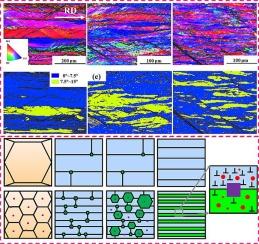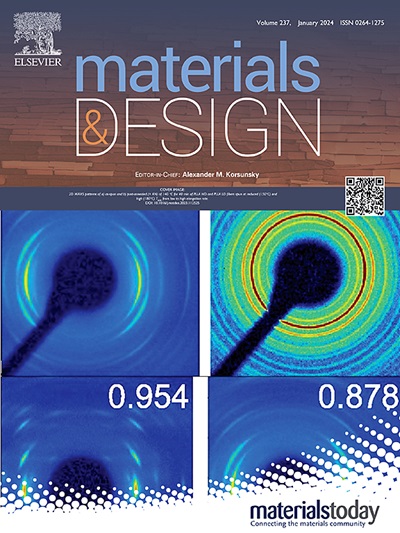Microstructure evolution from homogeneous as-cast state to annealed heterogeneous structure and mechanical properties of Al-Zn-Mg-Cu alloys with trace TiB2 particles
IF 7.9
2区 材料科学
Q1 MATERIALS SCIENCE, MULTIDISCIPLINARY
引用次数: 0
Abstract
Materials with a final heterogeneous structure (HS) possess an excellent combination of strength and ductility. However, fine and homogeneous grains are desired in as-cast ingots to avoid defects. The evolution from an as-cast homogeneous microstructure to a pronounced HS owing to the trace addition of TiB2 particles was studied in Al-Zn-Mg-Cu alloys with traditional thermomechanical treatment. It is revealed that the triple junctions and over 2 μm precipitates co-located with TiB2 enhance the particle-stimulated nucleation of recrystallization. The dislocation density difference between the recrystallized and recovered grains is further enhanced by cold rolling. A pronounced HS with alternating soft and hard domains accompanied by multimodal precipitates is modulated, realizing a synergy of yield strength as 632.4 MPa and elongation as 8.8%. It is confirmed that the HS, rather than precipitates, is the primary source of geometrically necessary dislocations (GNDs), leading to the synergy of strength and ductility. Atomistic simulations on the deformation behavior of HS were used to elucidate the strain partition and role of GNDs on mechanical properties. Our results provide a convenient route to fabricate heterogeneous Al-Zn-Mg-Cu alloy by trace addition of ceramic particles in ingots casting instead of elaborated controlling of deformation processing.

含有痕量 TiB2 粒子的铝锌镁铜合金从均质铸造状态到退火异质结构的微观结构演变及力学性能
具有最终异质结构(HS)的材料兼具出色的强度和延展性。然而,为了避免缺陷,铸锭中需要细小均匀的晶粒。通过传统的热机械处理工艺,研究了铝锌镁铜合金在微量添加 TiB2 粒子后,从铸造时的均匀微观结构演变为明显的 HS 结构的过程。研究发现,与 TiB2 共位的三重交界和超过 2 μm 的析出物增强了粒子刺激的再结晶成核。再结晶晶粒和复原晶粒之间的位错密度差在冷轧过程中进一步增大。在多模式析出物的伴随下,形成了明显的软域和硬域交替的 HS,实现了屈服强度 632.4 MPa 和伸长率 8.8% 的协同效应。研究证实,HS(而非析出物)是几何必要位错(GND)的主要来源,从而实现了强度和延展性的协同作用。通过对 HS 变形行为的原子模拟,阐明了应变分区以及 GNDs 对机械性能的作用。我们的研究结果为通过在铸锭过程中微量添加陶瓷颗粒来制造异质铝-锌-镁-铜合金提供了一条便捷的途径,而无需精心控制变形过程。
本文章由计算机程序翻译,如有差异,请以英文原文为准。
求助全文
约1分钟内获得全文
求助全文
来源期刊

Materials & Design
Engineering-Mechanical Engineering
CiteScore
14.30
自引率
7.10%
发文量
1028
审稿时长
85 days
期刊介绍:
Materials and Design is a multi-disciplinary journal that publishes original research reports, review articles, and express communications. The journal focuses on studying the structure and properties of inorganic and organic materials, advancements in synthesis, processing, characterization, and testing, the design of materials and engineering systems, and their applications in technology. It aims to bring together various aspects of materials science, engineering, physics, and chemistry.
The journal explores themes ranging from materials to design and aims to reveal the connections between natural and artificial materials, as well as experiment and modeling. Manuscripts submitted to Materials and Design should contain elements of discovery and surprise, as they often contribute new insights into the architecture and function of matter.
 求助内容:
求助内容: 应助结果提醒方式:
应助结果提醒方式:


